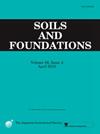Centrifuge model tests on liquefaction-induced settlement of river embankments reinforced by floating-type cement treatment method
IF 3.3
2区 工程技术
Q2 ENGINEERING, GEOLOGICAL
引用次数: 0
Abstract
Loose sandy soil layers are prone to liquefaction under strong earthquakes, causing damage to civil engineering structures inside or upon the liquefied ground. According to the present Japanese design guideline on liquefaction countermeasures for river levees, the entire depth of the liquefiable subsoil below river embankments should be improved. However, this approach is not economical against deep liquefiable subsoil. To rationalize the design approach, this contribution investigated the performance of a floating-type cement treatment method, in which only the shallower part of the liquefiable subsoil is reinforced. A series of centrifuge shaking table model tests was conducted under a 50 environment. The depth of improvement (cement treatment) was varied systematically, and the effect of the sloping ground was examined. The experimental results revealed that the settlements of river embankments can be reduced linearly by increasing the depth of improvement. Moreover, the acceleration of embankments can be reduced drastically by the vibration-isolation effect between the cement-treated soil and the liquefiable soil. These effects contribute to the safe retention of the embankment shape even when the liquefied sloping ground causes lateral flows. Towards practical implementation, discussions on the effect of permeability on cement-treated soil were expanded. Furthermore, the stress acting on cement-treated soil during shaking was measured using an acrylic block to explain the occurrence of cracks in the soil.
浮式水泥加固河堤液化沉降离心模型试验
松散的沙质土层在强震作用下容易发生液化,对液化地面内部或上面的土木工程结构造成破坏。根据日本现行的河堤液化对策设计指南,应提高河堤以下可液化底土的整体深度。然而,对于深层可液化地基,这种方法并不经济。为了使设计方法合理化,本文研究了浮式水泥处理方法的性能,该方法仅对可液化地基的较浅部分进行加固。在50g环境下进行了一系列离心振动台模型试验。系统地改变了改善(水泥处理)的深度,并对倾斜地面的效果进行了检验。试验结果表明,增加堤防加固深度可以线性降低堤防沉降。此外,水泥处理土与液化土之间的隔振效应可以显著降低路堤的加速度。这些影响有助于即使在液化的倾斜地面引起横向流动时也能安全保持路堤形状。面向实际应用,扩展了对水泥土渗透性影响的讨论。此外,使用丙烯酸块测量了震动过程中作用在水泥处理土壤上的应力,以解释土壤中裂缝的发生。
本文章由计算机程序翻译,如有差异,请以英文原文为准。
求助全文
约1分钟内获得全文
求助全文
来源期刊

Soils and Foundations
工程技术-地球科学综合
CiteScore
6.40
自引率
8.10%
发文量
99
审稿时长
5 months
期刊介绍:
Soils and Foundations is one of the leading journals in the field of soil mechanics and geotechnical engineering. It is the official journal of the Japanese Geotechnical Society (JGS)., The journal publishes a variety of original research paper, technical reports, technical notes, as well as the state-of-the-art reports upon invitation by the Editor, in the fields of soil and rock mechanics, geotechnical engineering, and environmental geotechnics. Since the publication of Volume 1, No.1 issue in June 1960, Soils and Foundations will celebrate the 60th anniversary in the year of 2020.
Soils and Foundations welcomes theoretical as well as practical work associated with the aforementioned field(s). Case studies that describe the original and interdisciplinary work applicable to geotechnical engineering are particularly encouraged. Discussions to each of the published articles are also welcomed in order to provide an avenue in which opinions of peers may be fed back or exchanged. In providing latest expertise on a specific topic, one issue out of six per year on average was allocated to include selected papers from the International Symposia which were held in Japan as well as overseas.
 求助内容:
求助内容: 应助结果提醒方式:
应助结果提醒方式:


